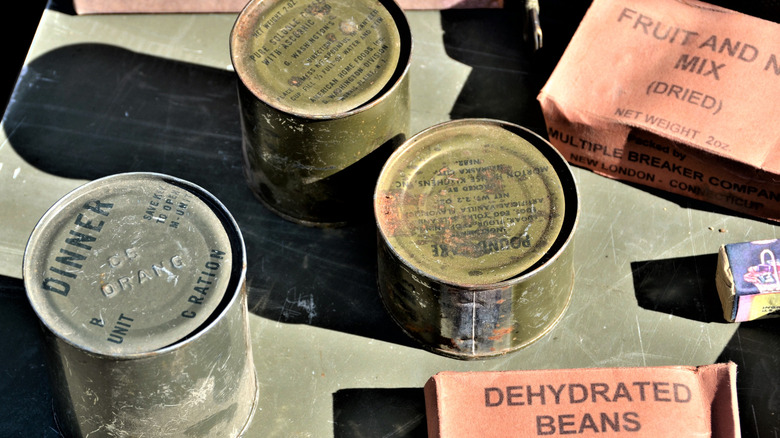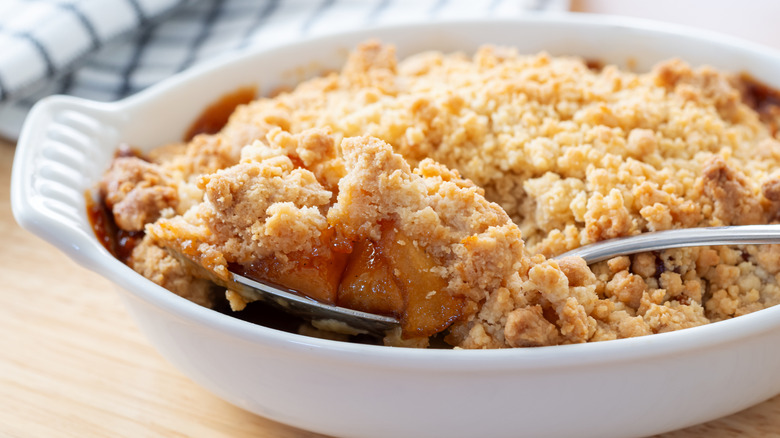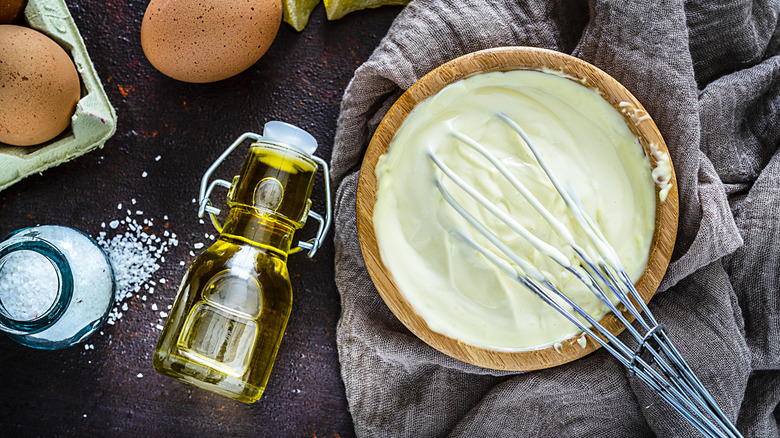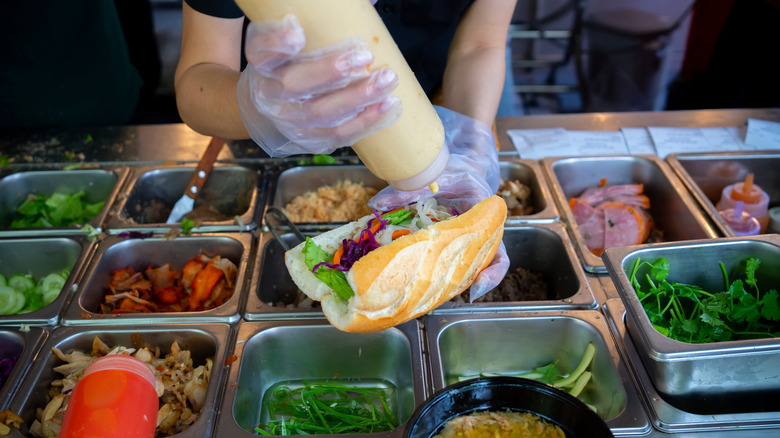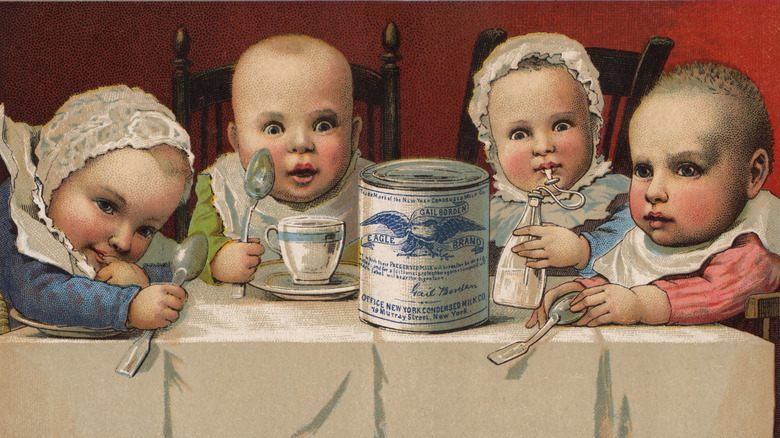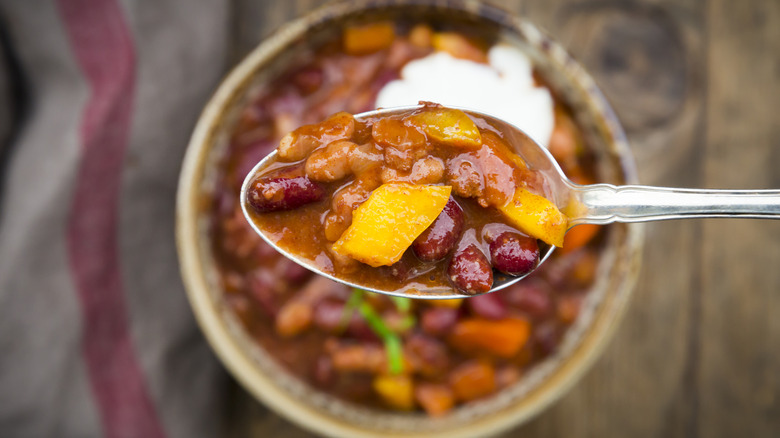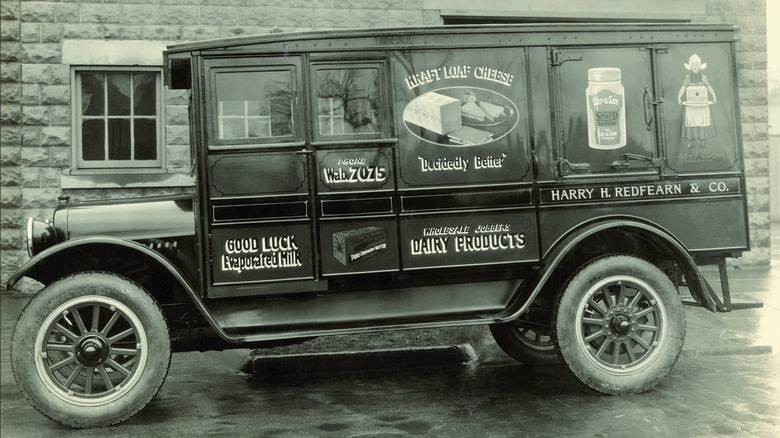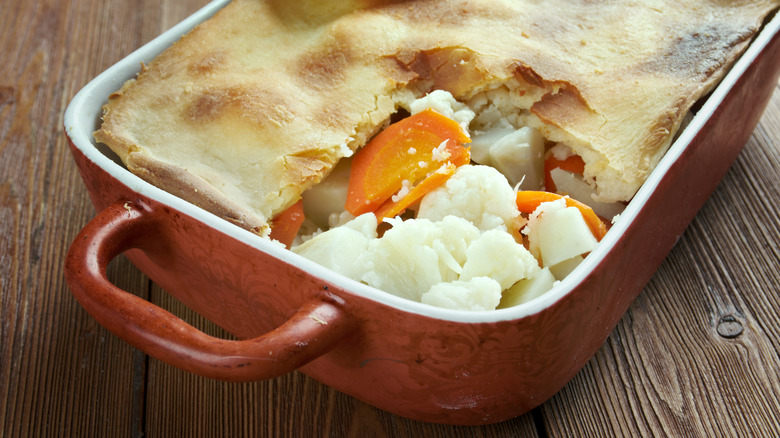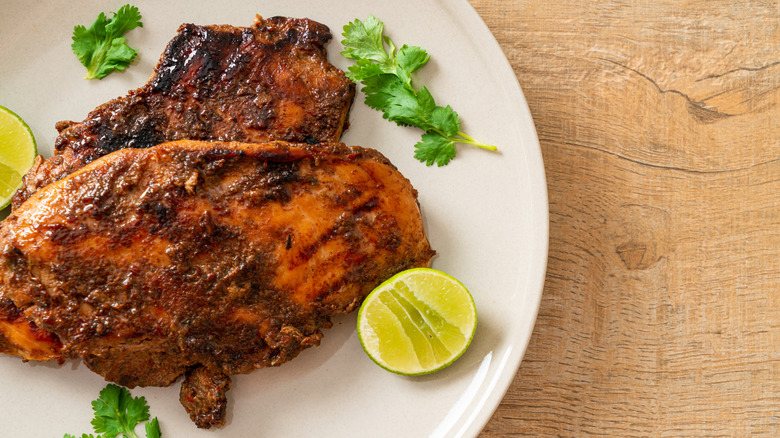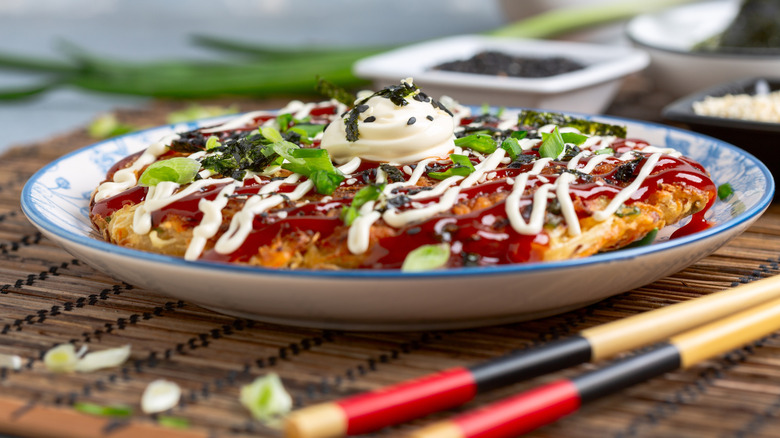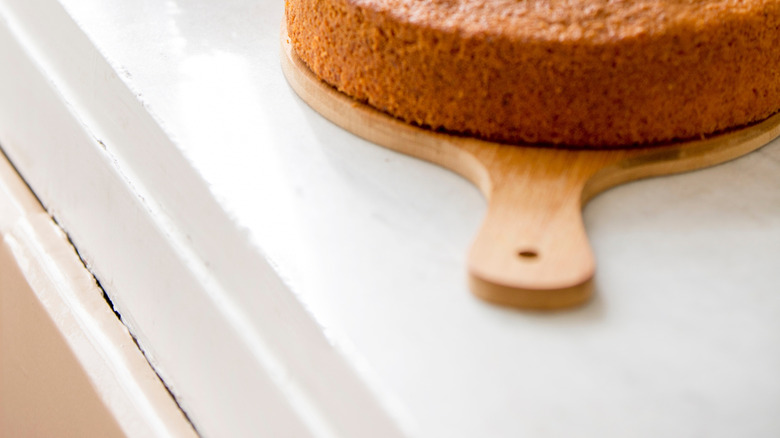Classic Foods That Were Made Popular During Wartime
War has always impacted food supply. Throughout history, it's been equally responsible for food shortages and dietary innovations. Food scarcity amongst civilians on the home front and the need to efficiently feed soldiers on the front lines have both been the impetus for the creation of a surprising number of foods that we know and consume regularly today. Some of these were created to commemorate victorious battles, while others were invented or popularized to creatively navigate wartime rationing or post-war food shortages.
From preservation techniques dating as far back as the Civil War to the snacks invented during WWII that we still enjoy today, you'd be surprised just how many foods — sweet, savory, processed, and otherwise — we regularly consume as the direct result of war's influence. With origins surrounding some of history's most significant and international conflicts, here's 12 classic foods that were made popular during wartime.
Apple crumble
It's true that predecessors of the crumble existed well before the 1940s, but variations on this simple dessert — cooked fruit covered in a crumbly topping — were less desirable than cakes and pies during times when there was no shortage of sugar, butter, or pastry flour. The apple crumble didn't become widely consumed until food scarcity during WWII necessitated the adaptation of go-to recipes. The crumble was a reimagining of the apple pie in the UK when rationing and food shortages were at their peak.
A recipe that could curb a sweet craving without requiring the typical butter and sugar necessary for other more conventional desserts, the crumble didn't require much in its preparation. The topping could be made with coarse flour and fat — margarine, shortening, or oil in a pinch — and easily provided a nice texture. If no sweetener was available, a crumble relied solely on the apples' natural sweetness, becoming a hearty comfort dessert during hard times. Unlike many war-era foods that fell out of favor once rationing no longer dictated food supplies, the apple crumble has remained a favorite ever since. It has come to enjoy international popularity after upgraded post-ration era recipes using butter and sugar have further enhanced the crumble's tastiness.
Mayonnaise
Now conveniently available in jars and bottles at any neighborhood grocer and frequently spread on sandwiches, it might be hard to believe that mayonnaise has origin story which links it to the Seven Years War. While no one can fully corroborate the stories, no one can officially deny them either. One version of the tale suggests a French chef whipped up something new when trying to create a sauce that could compensate for a lack of cream. His solution was whisking eggs and oil, which combined into an airy texture if whipped together with enough patience.
As for why this chef was so determined to whip up something a little more luxe than what was available, more lore suggests that this first instance of mayonnaise was served as part of a celebratory dinner hosted for the duc du Richelieu. This occasion was held in honor of his victory at the Battle of Minorca, also known as the Battle of Mahon, in 1756. The site of a crucial naval victory against Britain which launched the Seven Years' War, Mahon may indeed have been the origin for the name of this airy, creamy condiment. Regardless of the amount of truth in this origin tale, it's certainly the French who popularized mayonnaise. To this day, many still generally prefer to whip it up from scratch rather than buying it pre-prepared.
Bahn Mi
Banh mi is a sandwich with ties to the history of French colonial rule in Vietnam. When the French arrived in the mid-1800s, they brought their dietary customs with them. This consisted of a lot of bread and cured meat, two things foreign to the locals' diet. Wheat was imported, making bread — typically consumed as baguettes — an expensive commodity locals couldn't really afford until WWI. This was when many French left Vietnam to partake in the war effort, leaving behind a surplus of imported goods, including bread and cured meats. Once locals got a taste for bread, it quickly became a staple, though shortages led to recipes made with varying percentages of rice flour. Locals continued to eat this bread with butter and cured meats à la Française.
As anti-French sentiment brewed post-WWII, communist revolutionary Ho Chi Minh declared Vietnam's independence in 1945, prompting war with France. This led to the country being split in two, with thousands fleeing the Communist half before a border was established, including one family who opened up a sandwich shop in Saigon. To make everything more affordable, baguettes were reduced in size and served with mayonnaise instead of butter, and, due to reduced meat, the sandwich's filling was supplemented with more vegetables. All was packed inside the bread to make it easy to eat on the go. Other vendors began to replicate this banh mi concept, adding pickles and other sauces to gradually create a sandwich that became a Vietnamese classic.
Condensed milk
Something primarily used in select baking recipes and specialty drinks today, condensed milk is often taken for granted in the baking aisle of any grocery store. But it was originally invented as a means of addressing public health concerns, and its origins date back to just before the Civil War. Condensed milk first appeared in the mid-1800s as an alternative to fresh milk before pasteurization. This was intended to be a solution to the fresh milk at the time which was sometimes tainted, resulting in illness or death for those who consumed it. How condensed milk is made doesn't differ much from the original innovation. The process consists of adding sugar to milk and removing 60% of its water content.
Despite posing a plausible alternative to contaminated milk, condensed milk didn't catch on with consumers until the United States Army contracted mass production for its troops. Sweetened condensed milk fortified these soldiers throughout the Civil War, and later became a staple in American soldiers' rations on the European Front during the First World War. Omnipresent within the ranks of the US Army, condensed milk gradually found its way into civilian kitchens, but found even more popularity in tropical climates, where it offered a version of dairy that was in no danger of spoiling despite heat and humidity. To this day, the legacy of condensed milk's popularity in tropical regions around the world prevails through drinks like Vietnamese iced coffee and desserts such as dulce de leche.
Chili
Two suspected culinary influences for chili con carne include indigenous recipes for stewing local game with spices and the Moroccan-influenced cooking traditions from Canary Island immigrants to San Antonio, Texas in the 1700s. The dish retains close ties with San Antonio, where a recognizable version of the chili we know today was served by women known as "Chili Queens" starting sometime in the 19th century.
Chili's origin tale is legend, linked to the Mexican War of Independence – specifically an uprising in 1813. This was a fight between Royalists loyal to Spanish rule and various rebels: Those who wanted Texas to join a free Mexico, those who favored joining the United States, and those who envisioned Texas as an independent republic. Joining forces in the common cause to liberate Texas, these rebels took control of San Antonio and executed the local leaders, an act which disgusted the Royalist locals. Hoping to starve out their invaders, they refused to feed the rebels until one young woman, Jesusita de la Torre, fell in love with a soldier. This association led to her family being ostracized to the point of starvation. With nothing to lose, they decided to open a restaurant featuring local specialties, including chili con carne, that would cater to the starving rebels. With no indoor venue available, the de la Torre family simply devised an open-air eatery in San Anonio's plaza. Thus was the beginning of a long-standing tradition of outdoor chili vendors, and the birth of Tex Mex cuisine.
Kraft cheese
Patented in 1916, Kraft cheese is another example of an innovation intended to prolong dairy's shelf life. A vision of salesman James L. Kraft, the original recipe entailed processing cheddar cheese by heating it up to kill bacteria and then mixing it with sodium phosphate. Eventually, Kraft cheese revolutionized the possibilities for packaged foods, but it wasn't easy to sell the public on this processed stuff at first.
However, the US Army immediately saw the appeal in a cheese that wouldn't spoil and contracted millions of pounds of Kraft cheese to include in soldiers rations during the First World War. This prevalence in army rations was enough to make the product mainstream, and it has been a popular brand of American cheese ever since. The wartime success of Kraft's slices enabled the company to further develop different forms of processed cheese, including transforming it into a powder. This became an integral component in the boxed Kraft macaroni and cheese which hasn't gone out of style since it first hit store shelves in 1937. Unlike the cheese slices which took awhile to catch on with civilians during WWI, this new Kraft mac and cheese was an immediate hit during the Second World War, as it was a cheap and simple way to feed a family while rations limited what was available.
Woolton pie
While the UK was under attack by German Luftwaffe bombings during WWII, food supplies ran dangerously scarce. Another dish to come out of wartime rationing and general food scarcity was the Woolton pie, a creative way of making something homey out of limited resources. One of many recipes that home cooks could easily replicate, Woolton pie was promoted on the wartime radio program "The Kitchen Front," but got its name from the Minister of Food of the time: Frederick Marquis, First Lord Woolton. He was the one who popularized this dish to the masses as part of a promotion of healthy, economical eating.
The savory pie is a simple mixture of seasonal vegetables thickened with oatmeal and cooked beneath a pastry topping, then served with brown gravy. Containing no meat, it was a shift from the heftier savory pies that made up traditional British fare, but deemed to have all the necessary nutrients that could keep the home front fighting fit. Though the recipe is infinitely modifiable depending on the vegetables in season, any appreciation civilians may have had for the dish during food shortages did not grant the Woolton pie much longevity beyond wartime. Today, steak and kidney or shepherd's pie are more highly prioritized as traditional British foods worth trying, and typically picked over meatless alternatives. Nevertheless, the Woolton pie remains a simple vegetarian recipe that's easy to reproduce.
Jamaican jerk
In 1655, an invasion known as the Anglo-Spanish war broke out between Spain and Britain for control over the island of Jamaica. As a result, Spain gave up its trading post to concentrate its energies on Cuba, leaving Jamaica to the British. Inhabited by the indigenous Taino people who had taken refuge in the mountainous regions where colonial forces dared not go, the island also had a population of enslaved African people brought over during Spanish rule. Many were able to escape to the mountains during the transition to British rule over the island. As British forces brought more enslaved labor to Jamaica to work on sugar plantations, those who had the chance to escape joined this mountain community, becoming known as the Maroons.
The Taino shared their cooking methods with the Maroons who came to the mountains, resulting in a fusion of flavors which have become known as Jamaican jerk. Wild boar was a primary source of sustenance, and the chosen method of preparing it was to cook the meat for many hours over the embers in an underground pit, taking no chances with smoke that might give away escapees' location to the British. Originally seasoned with pepper and pimento, the recipes for jerk seasoning have evolved over time to be flavored with additions such as garlic, ginger, and cinnamon. Today, other common traditional meats cooked with jerk seasoning in Jamaica include chicken and pork, and this quintessential flavor has achieved international renown.
Croissant
Despite its inextricable association with France today, the croissant's origins stem from an Austrian pastry called the kipfel. Made with lots of butter and baked into a special curved shape, this pastry became associated with legend linked to the Siege of Vienna in 1683. This was then the city defeated its Ottoman invaders, marking a successful deterrent against Ottoman expansion. As the story goes, it was a Viennese baker up earlier than the rest of the city who heard the Ottomans' approaching and sounded the alarm. Kipfel pastries, which existed well-before this event, may have been popularized after the siege for their likeness to the crescent on the Ottoman flag, a further reminder of the locals' victory — though this too may just be more lore.
Somehow the kipfel made it to France, and further uncorroborated tales link this pastry's immigration to Marie Antoinette. She came from Vienna before becoming a French queen and may have brought a taste for local pastries with her. But an origin tale with more evidence suggests that the person responsible for bringing the kipfel to France was a Viennese baker who set up shop in Paris in the early 19th century. Sometime thereafter, the kipfel became the Frenchified croissant when made with puff pastry, and has been a local staple ever since. Curiously, the croissant belongs to a category of baked goods that are neither bread nor pastry. They are viennoiseries, a further nod to the true origins of this adopted French specialty.
Okonomiyaki
Okonomiyaki, a Japanese savory pancake topped with a generous helping of invariable toppings and a decadent sauce, is a dish to which two cities lay claim. Osaka is where the dish got its name, but Hiroshima's version is the one that is best known today. While variations date back to Japan's Edo Period, okonomiyaki didn't transform into the beloved staple it is today until necessity struck in 1945. When the United States dropped the Atomic bomb on Hiroshima, the result was catastrophic devastation, and an unparalleled food scarcity for those who survived the blast. Salvaging pans from the wreckage, locals relied on whatever they could easily find to eat, and the result was adaptations on the extant concept of savory pancakes — a mixture of flour from U.S. rations topped with simple, hardy vegetables, like cabbage, and whatever else was available.
As Hiroshima recovered from the blast and food become available in more abundance, okonomiyaki continued to be a staple, retaining its possibilities for diverse variations while still keeping the same base ingredients. All recipes start with the simple pancake, and are typically topped with cabbage or onions before meat — everything from pork belly to fresh-caught seafood — and soba noodles get added on top. Then comes the special okonomiyaki sauce, slightly sweet and savory all at once. Though it may not be where okonomiyaki originates, the dish has become an important symbol of Hiroshima's culinary identity. There are over 2,000 okonomiyaki restaurants in Hiroshima alone.
Carrot cake
Though carrot cake has medieval origins, this concept of baking vegetables into cakes wasn't particularly mainstream in the UK until WWII. Because sugar was among the resources strictly rationed amongst civilians, home cooks worked out creative ways to bake with makeshift sweeteners. Carrots, a vegetable that's naturally on the sweeter side, became an obvious choice, and carrot cake a regular feature in wartime cooking. Though the use of this vegetable did indeed function as an effective replacement for limited sugar, there was also an entirely separate wartime reason prompting home cooks to use more carrots.
Via the mascot Doctor Carrot, civilians were encouraged to grow these in home gardens through a propaganda campaign suggesting these vegetables would improve vision during the blackouts that were then a regular occurrence in London. These blackouts were a means of making German aerial bombing raids less capable of finding their targets, giving the British Royal Air Force (RAF) a chance to beat their attackers at their own game. Government propaganda further encouraged vegetable consumption by suggesting that a diet full of carrots gave RAF pilots heightened night vision to hunt down enemy planes. But this carrot cover story was much more fiction than fact, perhaps intended as a diversion to keep the air force's true secret weapon — special radar equipment — under wraps. The campaign did, however, produce a home front carrot surplus, and carrot cake was one of the tastier options to use up these vegetables.
Budae jjigae
This popular stew enjoyed the world over is an enduring fusion dish born out of wartime necessity. Its origins come from the Korean War, when food scarcity prompted locals to seek out the only places that didn't have food shortages — American army bases. This is where locals lined up to purchase the leftovers from the army mess, often scraps that were intended for the trash. What these scavengers came away with were processed foods, especially meats like SPAM and hot dogs, that didn't spoil easily. They mixed these savory protein sources into vegetable soups, adding their own twist of flavor with Korean spices. The dish became known as budae jjigae, or "army base stew."
Postwar Korea still struggled with food resources, and processed meat remained the only feasible protein source for many — but it was only available on the black market. Despite the possibility of extreme consequences for acquiring these ingredients, the stew continued to be a regular feature in locals' diets. Some came to stigmatize the dish due to its association with hard times, but others embraced the fact that it was tasty and innovative. Today, budae jjigae is no longer a dish of necessity, but has been reimagined beyond its ties to darker times into a hearty, warming comfort food.
